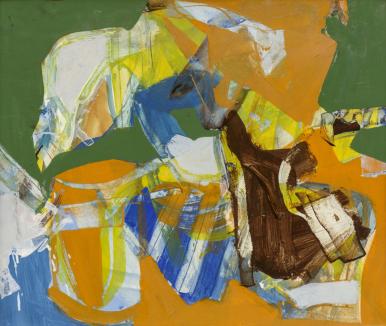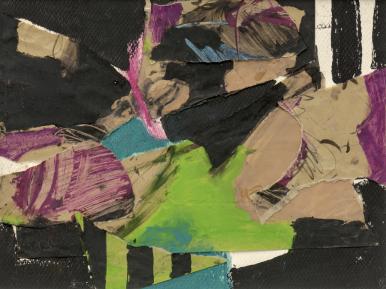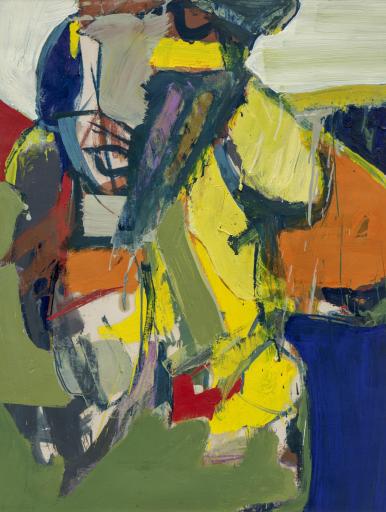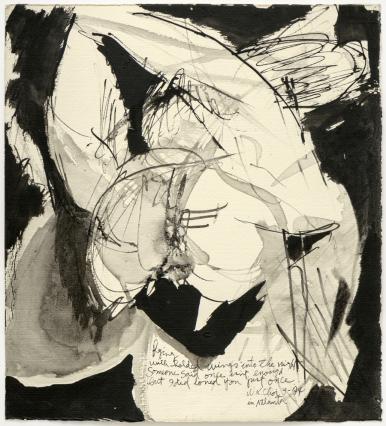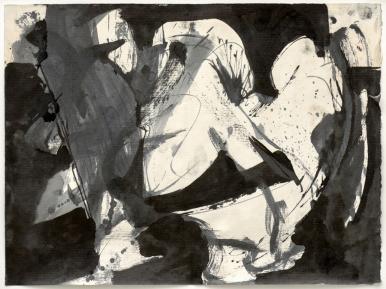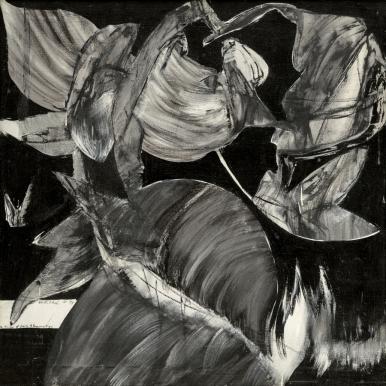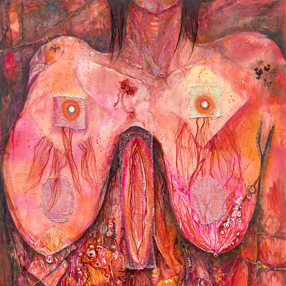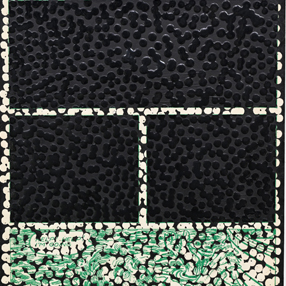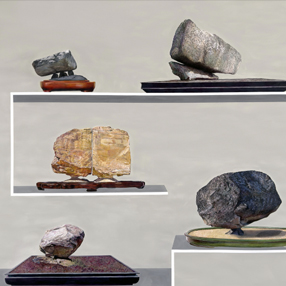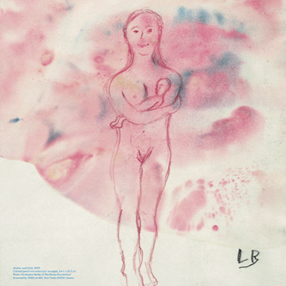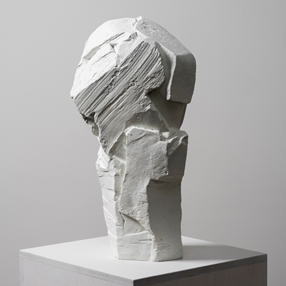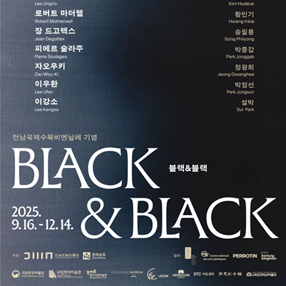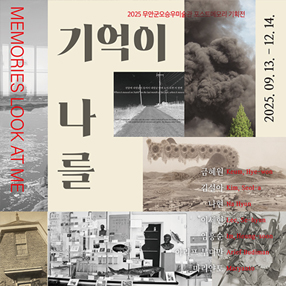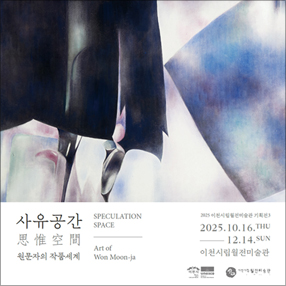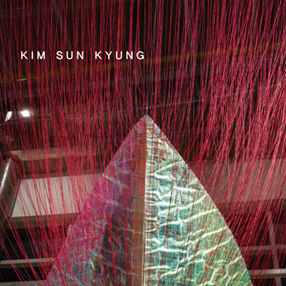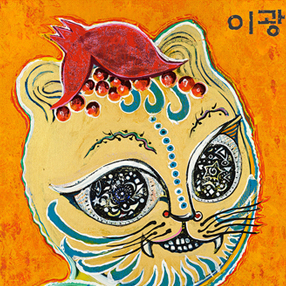본문
-
최욱경
Untitled, c. 1960s Acrylic on hardboard 34 x 40 cm
-
최욱경
Untitled, c.1960s Paper collage, acrylic, and oilpastel on paper 25 x 32.5 cm
-
최욱경
Untitled, c.1960s Acrylic and oil pastel on paper 62 x 47.5 cm
-
최욱경
Untitled, 1974 Ink and pen on paper 28 x 25 cm
-
최욱경
Untitled, c.1960s Ink on paper 24 x 32 cm
-
최욱경
The Raven of Death andResurrection, 1975 Acrylic on canvas 85 x 85 cm
-
Press Release
"여자이자 화가로서의 나의 경험은 내 창의력의 원천이 되었다. 내 작품에는 과거와 현재의 경험이 반영되어 있다. 각각의 작품은 내 삶의 성장이고, 내 감정을 시각 언어로 풀어놓은 것이다. 내 작품들이 나의 삶에 대한 것이기는 하나, 이를 통해 단지 이야기만 들려주려는 것은 아니다. 나는 내가 살아온 순간들을 ‘시각적으로’ 표현하고자 노력한다. 그리고 나의 작품을 보는 이들이 이러한 경험을 공유하고, 소통하며, 공감하기를 바란다.”
– 최욱경
국제갤러리는 오는 6월 18일 강렬한 색채의 사용과 대담한 필치를 통해 국제적이면서 한국적인 추상회화의 기법을 이끌었다 평가받는 최욱경(1940-1985)의 개인전 《Wook-kyung Choi》를 개최한다. K1건물의 재개관을 기념하여 기획된 이번 전시는 지난 2005년, 2016년에 이어 세 번째로 열리는 개인전으로, 특히 1960년대부터 1975년경 사이에 제작된 흑백 잉크 드로잉과의 관계 속에서 최욱경의 회화와 콜라주 작업에서 드러나는 탈관습적인 실험 전반을 조명해볼 수 있는 기회를 제공한다.
K1의 나란한 두 공간에서는 추상회화와 콜라주로 구성된 컬러 작업, 그리고 잉크 드로잉이 주를 이루는 흑백 작업을 각각 선보인다. 먼저 도로를 면하고 있는 새로운 전시공간에서는 조형 면에서 흑백 매체를 통한 다양한 실험의 연장선상에 위치한 작은 사이즈의 회화 작업들을 전시한다. 이 회화 작품들에는 유화, 아크릴 물감뿐 아니라 목탄, 콩테, 오일 파스텔, 잉크 등 다양한 재료가 혼재하며, 특히 작가가 크랜브룩 미술학교에서 수학하던 시절에 작업한 다수의 초기작들이 포함되어 있다. 이번에 선보이는 회화 작품들은 미국 추상표현주의 작가인 윌렘 드 쿠닝의 자유분방한 선과 로버트 마더웰의 추상적이면서도 명상적인 회화면을 상기시키는 반면, 함께 선보이는 콜라주 작품들은 현실의 이슈들을 즉각적으로 반영했던 팝아트나 일상의 물질적 소재를 캔버스 평면에 덧붙여 작업한 컴바인 페인팅의 영향을 보여준다. 이는 작가가 특정 사조를 표방하거나 고집하는 대신 형태와 공간에 관한 연구를 통한 주제의식의 표현에 더욱 심혈을 기울였음을 보여주고 있다.
두 번째 전시공간에는 추상적인 선과 문구로 구성된 잉크, 목탄, 콩테를 이용한 드로잉과 판화를 선보인다. 그 중 잉크 드로잉은 검은 선과 흰 배경이 동일하게 추상적인 의미를 지닌 또 다른 추상표현주의 작가 프란츠 클라인의 작업뿐 아니라 둘의 역할이 글자와 바탕(여백)으로 보다 명확하게 구분되어 다양한 의미들로 가득 찬 동양의 서예를 동시에 연상시킨다. 최욱경은 실제로 먹을 활용하기도 했지만 주로 한지가 아닌 인화지처럼 광택이 있는 종이 위에 그렸고, 이는 기계를 이용하는 인쇄와 손으로 그리는 드로잉이라는 서로 이질적인 두 매체를 혼용한 예가 된다. 이러한 혼종성(hybridism)은 본 전시에서 함께 선보이는 판화 작업을 통해 더욱 부각된다. 다양한 매체의 실험을 통해 구축한 최욱경의 독자적인 조형양식은 미국 추상표현주의자들의 작업처럼 비실재적이고 무한한 공간으로서의 추상이 아닌 ‘대상의 존재를 느낄 수 있는’ 현실에 기반한 추상으로 이끌었고, 이는 작가가 평소 에세이를 쓰고 동료 작가와 시집을 출간한 사실과도 무관하지 않다.
1976-77년에 최욱경과 함께 로스웰미술관 입주작가 프로그램에 참여하여 그녀와 가까운 친구 사이로 지낸 화가 마이클 애커스(Michael Aakhus)는 최욱경에 대해 이렇게 회상한 바 있다. “젊은 나이에 미국으로 건너와 미국과 한국 두 나라 중 어디에서도 편하게 느낄 수 없던 채로 그 두 세계 사이에서 성장했다(She came to our country as a young woman and grew up between two worlds, unable to feel comfortable in the States or in her own country)”. 1960-70년대의 한국 미술계는 최근 국제적인 주목을 받고 있는 미술운동인 단색화와 한국 아방가르드 운동이 지배적이었다. 더불어 인종차별이 공공연한 이슈가 되곤 하던 미국 사회에서 아마도 외국인이자 여성으로서 작가가 느꼈을 문제의식을 감안한다면, 주제의 다양성을 탐구하고 작업을 통해 본연을 파악하는 일이 그에게 얼마나 중대하고 시급한 일이었을 지를 짐작해볼 수가 있다. 무엇보다도 이 시급성이 당대 동서양의 시류를 동시에 반영하는 새로운 조형언어를 탄생시켰다. 따라서 이번 최욱경의 개인전은 한국 미술계에서는 볼 수 없었던 어떠한 가능성에 대한 열망의 증거일 뿐 아니라 후대로 하여금 남성 작가 중심으로 쓰여졌던 한국 모더니즘 및 포스트모더니즘 미술의 새로운 기술(記述)을 가능케 하는 소중한 기회를 제공해 준다.
My experiences, as a woman and a painter, serve as a daily source for the creative inspiration necessary for my work. My paintings are collaged bits of time from my past and present experiences. Each work has its own life as the forms grow and I convey my feelings into a visual language. My paintings are about my life but I am not simply telling stories. I am trying to express, visually, my experience of the moment lived. I hope to share, to communicate, and to create an empathy for the experience.
– Wook-kyung Choi
Kukje Gallery is pleased to announce a solo exhibition of Wook-kyung Choi (1940-1985), an artist known for her bold abstract paintings and works on paper whose practice signaled a timely intercultural exchange between the United States and Korea. This inaugural show of Wook-kyung Choi’s work at Kukje Gallery’s newly renovated K1 building marks the artist’s third exhibition at the gallery following shows in 2016 and 2005. On view from June 18 through July 31, 2020, and covering the two exhibition spaces on the ground floor of the building, the exhibition provides an opportunity to survey Choi’s groundbreaking experimentation evident in her paintings and collages, with respect to her black and white ink drawings produced from the 1960s through 1975.
The first of the two adjacent gallery spaces in the K1 building showcases Choi’s signature use of color and abstraction as well as her innovative approach to collage, while the latter focuses on her black and white ink drawings. The first room exhibits a body of small paintings that serve as an extension of the diverse experimentation the artist undertook with the formal characteristics of black and white mediums. Initiated when she was a student at the Cranbrook Academy of Art, Choi’s abstract paintings powerfully illustrate her unique approach to expressionistic gestures and line employing oil paint and acrylic, in addition to charcoal, conté, oil pastel, and ink. While this body of paintings clearly evokes Willem de Kooning’s incisive brushwork and Robert Motherwell's abstract yet meditative pictorial planes, the collages, exhibited in tandem with the paintings, display the influence of pop art. For the artist, incorporating newspaper clippings and other media allowed for a direct response to the pressing social issues at the time; in this way, Choi engaged with the methodology of combine paintings which incorporated everyday objects affixed to the canvas. These two discrete but related bodies of work demonstrate the artist's strong commitment to personal expression and social commentary through brave exploration of form and content, and how she chose her own path instead of blindly following or adhering to a single artistic movement.
In the second gallery space, a comprehensive selection of Choi’s drawings and prints showcase her broad use of mediums including ink, charcoal, conté, and paper, while displaying the artist’s frequent use of abstract lines and text. The ink drawings evoke not only works of yet another abstract expressionist Franz Kline, whose signature use of broad black strokes against a white background introduced a unique strain of gestural abstraction, but also the traditions of East Asian calligraphy, wherein the stark contrast of the characters (positive space) and background (negative space) connotes a rich spectrum of meanings. While the artist did utilize Korean calligraphy ink, many of the drawings were subsequently done on coated printing paper, effectively merging two distinctive traditions—drawing by hand versus printing with machinery. This hybridism, deeply engrained in Choi’s practice, becomes even more apparent when viewed alongside her prints. The artist's unique formal sensibilities, forged by rigorously exploring and internalizing discrete mediums, led her to employ a form of abstraction where "the existence of the subject can be recognized," setting her apart from mainstream American abstract expressionists whose gestural abstraction was founded on an incorporeal space that broke away from traditional elements and narrative. This willingness to reveal herself in the work and specifically implement language on the canvas can also be attributed to Choi's interest in writing, as she authored multiple essays and published a collection of poems.
It is within this context that Choi’s friend and fellow painter Michael Aakhus, who first met Choi in 1976 for a ten-month residency under the auspices of the Roswell Museum of Art, reminisced that, “She came to our country as a young woman and grew up between two worlds, unable to feel comfortable in the States or in her own country." During the 1960s and 1970s, the Korean mainstream art world was dominated by Dansaekhwa, along with the Korean Avant-garde. Caught between her ambition to reach beyond these culturally specific movements in Korea and the social protest against patriarchy and racism in the United States, coupled with Choi’s position as a foreigner and a woman, made it imperative that she confront the crux of such pressing themes by charting undiscovered paths and new genres. Indeed, this sense of urgency and her unique status bridging the East and West led Choi to create a new formal language that remains to this day profoundly topical. It is only in retrospect that we can recognize the innovative work that Choi created during her lifetime, and under current circumstances can appreciate her influence on subsequent generations who continue to challenge the conservativism and male-dominated history of Korean modernism and postmodernism.전시제목최욱경(1940-1985)
전시기간2020.06.18(목) - 2020.07.31(금)
참여작가 최욱경
관람시간10:00am - 06:00pm / 일, 휴일 10:00am - 05:00pm
휴관일매주 월요일
장르회화
관람료무료
장소국제갤러리 Kukje Gallery (서울 종로구 소격동 58-1 국제갤러리 K1)
연락처02-733-8449
-
Artists in This Show
-
1940년 서울출생
-
국제갤러리(Kukje Gallery) Shows on Mu:umView All
Current Shows
-
정현: 그의 겹쳐진 순간들
PKM 갤러리
2025.10.22 ~ 2025.12.13
-
BLACK & BLACK
전남도립미술관
2025.09.16 ~ 2025.12.14
-
기억이 나를 본다
무안군오승우미술관
2025.09.13 ~ 2025.12.14
-
원문자: 사유공간 思惟空間
이천시립월전미술관
2025.10.16 ~ 2025.12.14
-
유리상자-아트스타Ⅲ 김선경 [無와 有의 경계에서]
봉산문화회관
2025.09.12 ~ 2025.12.14
-
먼지를 걷는 자들 Dust Walkers
신한갤러리
2025.11.13 ~ 2025.12.20
-
유리: 투명한 고리
갤러리 학고재
2025.11.19 ~ 2025.12.20
-
이광 개인전 《우주호랑이- 호랑이 여자로 산다는 것은》
갤러리 마리
2025.11.21 ~ 2025.12.20




